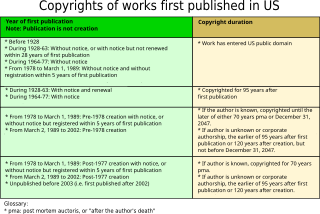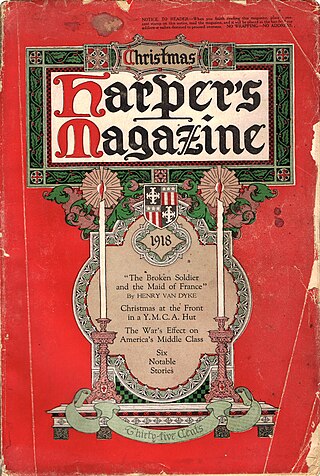A copyright is a type of intellectual property that gives its owner the exclusive right to copy, distribute, adapt, display, and perform a creative work, usually for a limited time. The creative work may be in a literary, artistic, educational, or musical form. Copyright is intended to protect the original expression of an idea in the form of a creative work, but not the idea itself. A copyright is subject to limitations based on public interest considerations, such as the fair use doctrine in the United States.
Eldred v. Ashcroft, 537 U.S. 186 (2003), was a decision by the Supreme Court of the United States upholding the constitutionality of the 1998 Sonny Bono Copyright Term Extension Act (CTEA). The practical result of this was to prevent a number of works from entering the public domain in 1998 and following years, as would have occurred under the Copyright Act of 1976. Materials which the plaintiffs had worked with and were ready to republish were now unavailable due to copyright restrictions.

The United States Copyright Office (USCO), a part of the Library of Congress, is a United States government body that maintains records of copyright registration, including a copyright catalog. It is used by copyright title researchers who are attempting to clear a chain of title for copyrighted works.

The Copyright Act of 1790 was the first federal copyright act to be instituted in the United States, though most of the states had passed various legislation securing copyrights in the years immediately following the Revolutionary War. The stated object of the act was the "encouragement of learning," and it achieved this by securing authors the "sole right and liberty of printing, reprinting, publishing and vending" the copies of their "maps, charts, and books" for a term of 14 years, with the right to renew for one additional 14-year term should the copyright holder still be alive.
Golan v. Holder, 565 U.S. 302 (2012), was a Supreme Court case that dealt with copyright and the public domain. It held that the "limited time" language of the United States Constitution's Copyright Clause does not preclude the extension of copyright protections to works previously in the public domain.

The Uruguay Round Agreements Act is an Act of Congress in the United States that implemented in U.S. law the Marrakesh Agreement of 1994. The Marrakesh Agreement was part of the Uruguay Round of negotiations which transformed the General Agreement on Tariffs and Trade (GATT) into the World Trade Organization (WTO). One of its effects is to give United States copyright protection to foreign works that had previously been in the public domain in the United States.

The Copyright Act of 1909 was a landmark statute in United States statutory copyright law. It went into effect on July 1, 1909. The 1909 Act was repealed and superseded by the Copyright Act of 1976, which went into effect on January 1, 1978; but some of 1909 Act's provisions continue to apply to copyrighted works created before 1978. It allowed for works to be copyrighted for a period of 28 years from the date of publication and extended the renewal term from 14 years to 28 years, for a maximum of 56 years.

The purpose of copyright registration is to place on record a verifiable account of the date and content of the work in question, so that in the event of a legal claim, or case of infringement or plagiarism, the copyright owner can produce a copy of the work from an official government source.

Kahle v. Gonzales, 487 F.3d 697 is a First Amendment case that challenges the change in the copyright system of the United States from an opt-in system to an opt-out system.

The Sonny Bono Copyright Term Extension Act – also known as the Copyright Term Extension Act, Sonny Bono Act, or (derisively) the Mickey Mouse Protection Act – extended copyright terms in the United States in 1998. It is one of several acts extending the terms of copyrights.
A trademark is a type of intellectual property consisting of a recognizable sign, design, or expression that identifies products or services from a particular source and distinguishes them from others. The trademark owner can be an individual, business organization, or any legal entity. A trademark may be located on a package, a label, a voucher, or on the product itself. Trademarks used to identify services are sometimes called service marks.

The Copyright Act of 1976 is a United States copyright law and remains the primary basis of copyright law in the United States, as amended by several later enacted copyright provisions. The Act spells out the basic rights of copyright holders, codified the doctrine of "fair use", and for most new copyrights adopted a unitary term based on the date of the author's death rather than the prior scheme of fixed initial and renewal terms. It became Public Law number 94-553 on October 19, 1976 and went into effect on January 1, 1978.
The copyright law of the United States grants monopoly protection for "original works of authorship". With the stated purpose to promote art and culture, copyright law assigns a set of exclusive rights to authors: to make and sell copies of their works, to create derivative works, and to perform or display their works publicly. These exclusive rights are subject to a time limit, and generally expire 70 years after the author's death or 95 years after publication. In the United States, works published before January 1, 1928, are in the public domain.

Works are in the public domain if they are not covered by intellectual property rights at all, or if the intellectual property rights to the works have expired.
The copyright status of works produced by the governments of states, territories, and municipalities in the United States varies. Copyright law is federal in the United States. Federal law expressly denies U.S. copyright protection to two types of government works: works of the U.S. federal government itself, and all edicts of any government regardless of level or whether or not foreign. Other than addressing these "edicts of government", U.S. federal law does not address copyrights of U.S. state and local government.
Copyright renewal is a copyright formality through which an initial term of copyright protection for a work can be extended for a second term. Once the term of copyright protection has ended, the copyrighted work enters the public domain, and can be freely reproduced and incorporated into new works.
Reed Elsevier, Inc. v. Muchnick, 559 U.S. 154 (2010), was a decision by the Supreme Court of the United States involving copyright law. The Court held that failure to register a copyright under Section 411 (a) of the United States Copyright Act does not limit a Federal Court's jurisdiction over claims of infringement regarding unregistered works.
The copyright law of the United States has a long and complicated history, dating back to colonial times. It was established as federal law with the Copyright Act of 1790. This act was updated many times, including a major revision in 1976.

A collective work in the copyright law of the United States is a work that contains the works of several authors assembled and published into a collective whole. The owner of the work has the property rights in the collective work, but the authors of the individual works may retain rights in their contributions. Electronic reproduction of the whole work is allowed, but electronic reproduction of the individual works on their own, outside the context of the work as a whole, may constitute an infringement of copyright.

The Copyright Alternative in Small-Claims Enforcement Act of 2020 is a United States law that establishes a small claims court-type system within the United States Copyright Office, known as the Copyright Claims Board, for copyright owners to seek damages under US$30,000 for copyright violations.






